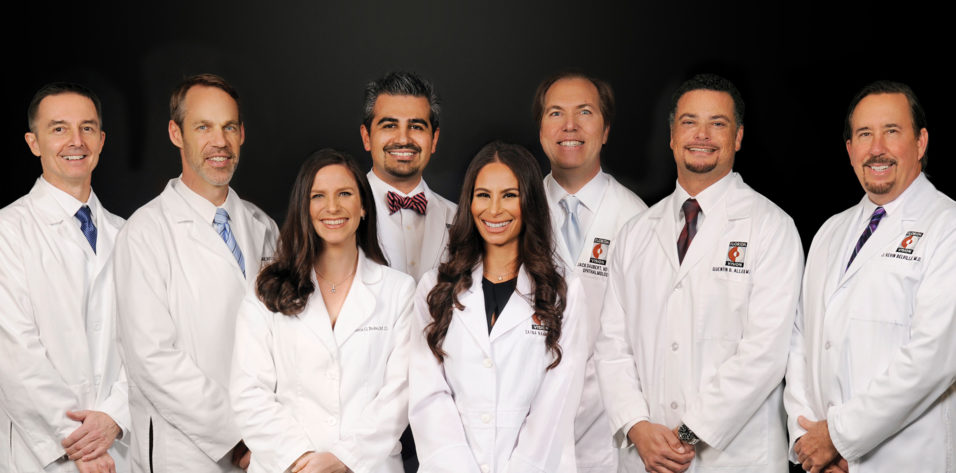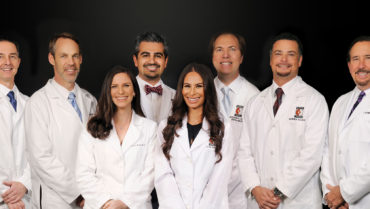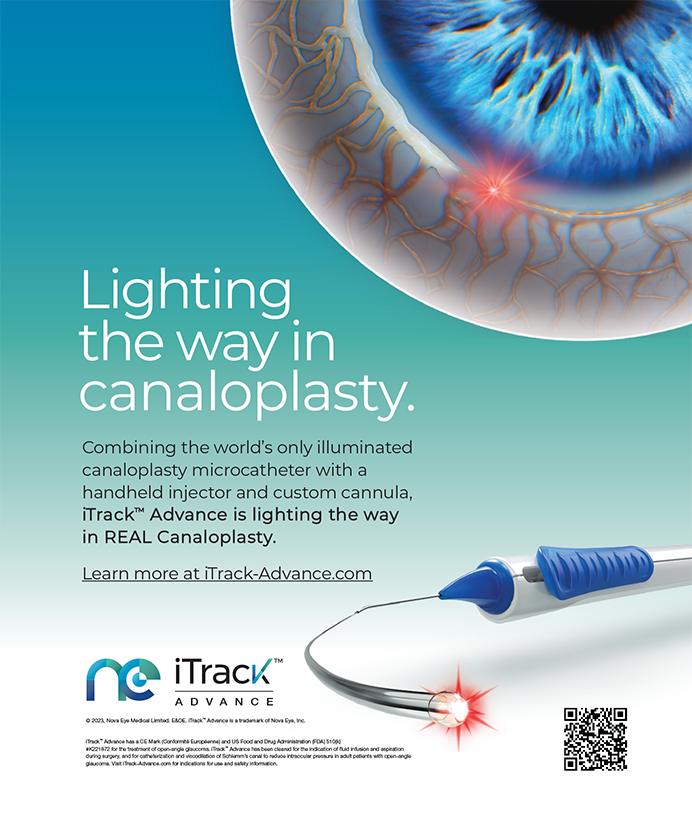
The Florida Vision Institute (FVI; www.flvisioninstitute.com) was founded as a solo practice in West Palm Beach in the early 1990s by its medical director, Jack Daubert, MD, who was motivated to pursue a career in ophthalmology by a childhood accident that temporarily blinded him. That ocular trauma was essentially the seed for what has blossomed into a multisite institution that provides cutting-edge vision correction options to patients throughout Florida’s Treasure Coast. This 30-mile swath of land includes Palm Beach County, among others, where the age and income demographics keep the demand for both refractive cataract surgery and LASIK high.
The practice’s reputation as a market leader helps draw talented ophthalmic surgeons from across the country such as Quentin B. Allen, MD, who joined the staff in 2014. In this article, Dr. Allen talks about FVI’s commitment to the early adoption of technology, the benefits of acquiring a femtosecond laser and intraoperative aberrometry, and why reducing surgical variables and managing patients’ expectations are as important as having the best and brightest surgeons and the best and newest technology. Practice Administrator and Chief Operating Officer Kathleen Koster and the office supervisor and surgical coordinator of FVI’s West Palm Beach office, Cindy Ralph, chime in about administrative aspects that keep the practice’s status as a market leader steady.
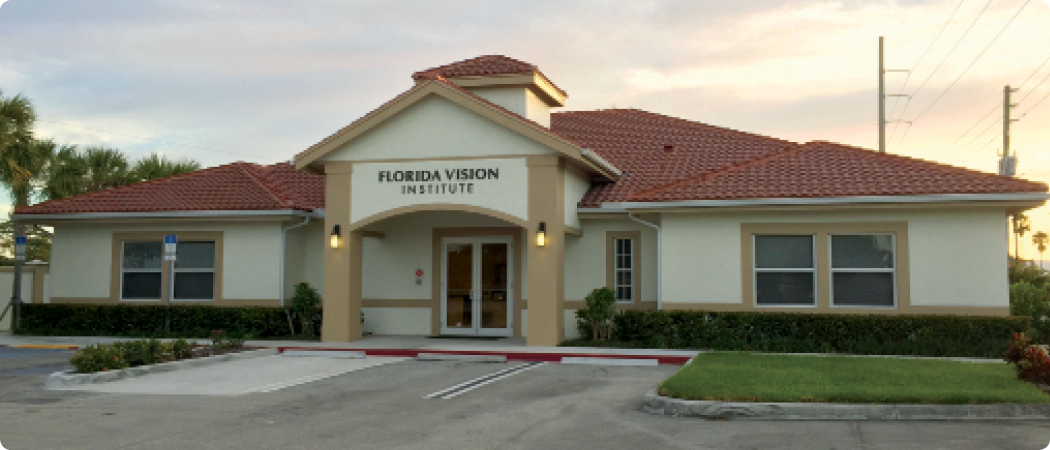
The office in Port St. Lucie.
CRST: Tell me a little bit about your background and what brought you to FVI.
Dr. Allen: I completed my internship at Mayo Clinic in Jacksonville, Florida, and my ophthalmology residency at Cleveland Clinic in Cleveland. After my residency, I was an attending physician at Cleveland Clinic Florida in Fort Lauderdale before moving to Peoria, Illinois, and joining the Illinois Eye Center. I was an associate professor at University of Illinois College of Medicine during that time. After several years there, I wanted to return to Florida to be closer to family, and this opportunity with FVI arose.
They recruited me, and I knew it was a premium practice that had a long history of excellence in cataract and refractive surgery due to Dr. Daubert, and I thought that it was a perfect fit for me. They had excellent staff, excellent surgical counselors, excellent techs, and they believe in investing in new technology, which is also very important to me. My goal is to provide every patient with some sort of vision correction; we have the tools to do that. Dr. Daubert and I had discussions about acquiring the femtosecond laser even before I joined the practice. I told him that I believed in the technology and that I thought it would be beneficial for the practice to have a femtosecond laser, and shortly after I joined FVI, we made it happen. We were the first practice in our area to acquire the technology for laser cataract surgery [LenSx Laser; Alcon]. That decision was an important step and a leap of faith by all of us.
CRST: FVI is a market leader. Can you provide some insight into this?
Ms. Koster: The geographical area in which we are situated is a bonus in that we cover three different counties: Palm Beach County, Martin County, and St. Lucie County. That positioning provides convenience and flexibility to patients. For instance, if they live in one county but work in another, they have easy access to us whether they are coming in on a day off or after work. Also, it gives the physicians the ability to move about among the five locations so that there’s always an opportunity for patients to see a particular subspecialist at a nearby office. Also, because we have a group of dedicated physicians, they cover for each other when they are on vacation or presenting at symposia or if they have an emergency and are in the ER. Regardless of these situations, we always have doctors in the office for patients who need to be seen.
CRST: What have you brought to FVI that enhances its standing as a leader?
Dr. Allen: During my 17 years in practice, I have tried to develop an approach centered around customizing refractive treatments to my patients. I don’t have a cookie-cutter or “one-size-fits-all” approach, and that fits well with a premium cataract and refractive practice like ours. I’m passionate about evaluating and adopting new technology that can be of benefit to my patients. I have been involved in teaching and consulting and trying to stay on the cutting edge to better serve my patients and recently completed a book chapter on multifocal lenses. I have continued to work with and educate our referring providers as well. My interests and strengths have helped to continue us along the path forged by Dr. Daubert—the vision of FVI [as] a premium practice with premium technology.
CRST: Talk about bringing a femtosecond laser system on board.
Dr. Allen: Our growth over the past 3 years has been excellent, and I feel that is in large part due to [our] making the decision to invest in that technology and to be the first to market in our area. After that, we were able to speak to our patients and referring doctors and essentially say, “We’re moving the ball forward.” This is something we started advertising directly to patients in local print media, and we saw benefits quickly. We saw interest in the laser technology, and we saw interest on the part of doctors who referred to us. Even those who didn’t fully understand the technology understood that we were on the cutting edge.
CRST: Is FVI marketing the laser’s outcomes or the technology?
Dr. Allen: We market its efficiency in surgery and the consistency of its outcomes. For me, cataract surgery is all about reducing the number of variables in surgery. I think consistency in capsulotomy size, centration, incisions, and the parameters of a perfect arcuate incision are all things [that] are not always humanly possible in every single case. That’s where the benefit of the laser is, and many studies support that. Once we made the purchase, it was a real plus to have new technology to talk to our referring physicians and optometrists about.
CRST: Are the femtosecond laser and intraoperative aberrometry especially helpful in Florida?
Dr. Allen: Florida’s demographics make for a unique market. We have throngs of cataract patients, and we also see plenty of 60-year-olds wanting LASIK. Many are people who were not early adopters of refractive surgery and have finally decided they want something done about their vision; most of them have cataracts, of course, at that point. We also see lots of cataract patients who had [radial keratotomy], [conductive keratoplasty], or LASIK 20 years ago who now want a vision “touchup.” It’s really important to be able to provide the outcomes those patients are looking for, and knowing that intraoperative aberrometry improves [the] consistency of results influenced our purchase of the ORA System [Alcon]. Once again, we were the first in our area to acquire this technology and now, in fact, have ORA in most of our ORs and in multiple surgery centers. The ultimate goals are to minimize the variables in cataract surgery, improve the outcomes, and increase our refractive predictability.
CRST: Is FVI satisfied with the benefits these investments in technology have brought?
Dr. Allen: Having this equipment increases my confidence. For instance, in the case of a high hyperope of +7.00 or +8.00 D wanting refractive lens exchange, we might have previously hesitated to perform clear lens extraction. Those cases can be a little tricky, and the femtosecond laser and intraoperative aberrometry help make them more routine. Our optometrists also note the higher degree of precision and excellent outcomes seen in our postoperative patients.
CRST: So, getting excellent results isn’t all about choosing ideal patients?
Dr. Allen: Correct. White cataracts, posterior polar lenses, [and] high hyperopes are all on the menu. I was on the ASCRS [Challenging] and Complicated Cataract [Surgery] Subcommittee a few years back, and we published “Cataract Surgery in the Small Eye,”1 and one of the things we mentioned in that article was that we thought tough anatomy was a place where [the] femtosecond laser could help improve the outcomes, and we have found that to be the case in practice.
Also, our own data tell us that the combination of [the] femtosecond laser and intraoperative aberrometry equates to excellent outcomes. Most recently, we looked at our results with the [AcrySof IQ Restor +2.5 Multifocal Toric IOL with Activefocus (Alcon)], and I presented [these] data in a talk at the Advanced Refractive Congress, showing that we are achieving 89% of patients within ±0.50 D of their intended spherical equivalent, and that’s with the combination of using LenSx and ORA.2
CRST: It sounds like the combination of a femtosecond laser and intraoperative aberrometry is bringing out the best in an already cutting-edge practice.
Dr. Allen: Exactly. An important part of being a successful refractive cataract practice is offering LASIK, and even in the case of LASIK, this technology offers benefits. For many years, we have offered all-laser LASIK with [the] IntraLase [Johnson & Johnson Vision] and Allegretto [Wave Eye-Q excimer laser system (Alcon)]. Along with my colleague Kevin Bellville, MD, who is also a well-known cataract and refractive surgeon, we both feel strongly about having the appropriate technology to perform an enhancement in a tricky case if we miss the target a bit. We want our patients to know that we have all the tools to reach the best possible outcome and it’s all part of a package price. We like our patients to know that one fee covers every eventuality. They can be confident that we will help them achieve their refractive goals—whatever those goals are—given the limitations of their anatomy.
Of course, not everybody is a candidate for everything. Acknowledging that is an important part of our success as well. We treat each patient individually; [someone] may want a certain technology, but if [he or she is] not a good candidate, then we direct [him or her] to different options.
CRST: What role does the staff play in FVI’s status as a market leader?
Dr. Allen: I know that, even in a challenging patient, we have the necessary tools to get my patients where they need to be, including technology and staff. Our surgical coordinators and technicians are equally as confidant in FVI’s surgeons and our technology. If a surgeon exudes confidence, but then the patient encounters others in the practice who don’t mirror that confidence or don’t sound as though they are educated about the procedures, the patient can lose faith. If I say the patient is a good candidate for the [Tecnis] Symfony [Johnson & Johnson Vision], Activefocus, or another lens, then the staff member has to trust that I believe that technology will work well with the patient, and [he or she has] to mirror that messaging.
While the vast majority of our refractive patients are very satisfied with their outcomes, we have to be extremely concerned about the 10% of patients who are not within 0.50 D of the intended spherical equivalent, because those patients are the ones who might be unhappy. There is a 2- to 4-month gap between the time when we can perform a YAG capsulotomy or do a LASIK enhancement after cataract surgery, and that’s when a surgeon and the staff can’t skip a beat; they need to be able to hold the patient’s hand and reassure [him or her] and have the confidence that [he or she] will ultimately get to [the] desired goal.
CRST: What are some staffing maneuvers in place that help inspire confidence?
Ms. Koster: You’re only going to be as good as your staff and your doctors, and we have top-notch doctors, and we pride ourselves in educating our staff to be top-notch. I’ve only been here a year, but in that time, we’ve done a lot to help bring out the best in an already well-run organization. For instance, we continue to look for areas of improvement, including cross-training our staff.
When you have five locations in three counties, you have to work as one family, one team. You have to educate everyone so that everyone’s working together, so it’s not an “us against them” mindset between staff and management. We standardize what we’re doing and what we say to patients so [that] they hear clear and consistent messaging about insurance issues and what out-of-pocket expenses they are responsible for, along with managing their expectations regarding their outcome. I’ve been in health care management for over 20 years and find that, regardless of practice specialty, the key components to success include well-trained staff that is able to convey consistent information to patients and also effectively manage [patients’] expectations.
CRST: How important is managing patients’ expectations to maintaining the practice’s reputation?
Dr. Allen: It is crucial to tell the cataract patients who already had LASIK … that there is a higher chance of [their] needing an enhancement so [that] they’re prepared mentally for that possibility. While they understand this intellectually, these patients can be a challenge. They have two problems: aberrations and lack of clarity from their cataract and likely some induced higher-order aberrations from their old LASIK flap.
They are also a bit more challenging, because they remember how quickly their vision improved after their initial LASIK surgery, so they are essentially expecting an overnight miracle to happen now. They sometimes say, “It’s been 20 years. The technology has improved. You should be able to fix everything immediately.” I have to first reduce their expectations to a normal level. Then, I explain that we do measurements during surgery to improve the accuracy [but that] it’s still a challenging scenario, because the ocular surface has been altered. It’s not virgin tissue. It may respond differently, and there’s a much higher chance that we might need to do a little touch-up afterward.
CRST: Can you quantify the growth that FVI has experienced since the addition of the femtosecond laser and intraoperative aberrometry?
Dr. Allen: This technology has definitely contributed to the practice’s growth. As soon as we started to market and advertise that we had the femtosecond laser, we began to get referrals from doctors specifically based on that, and we also got increased word-of-mouth referrals. I have actually had patients come in from their ophthalmologist up north requesting laser cataract surgery specifically. I can say that my surgical volume has increased approximately 15% to 20% over the past 3 years, and I believe that is in response to our adoption of new technology.
CRST: You have been with FVI for 12 years. What would you say makes the practice successful?
Ms. Ralph: I started when we had two locations, and now, there are five, so I’ve seen tremendous growth. I started here as an ophthalmic technician working in the clinic, and I have moved on to other roles. FVI believes in supporting continuing ophthalmic education and promoting from within, and I think this philosophy plays a large part in the practice’s success. It generates loyalty and commitment among the staff. Another key aspect is the practice’s commitment to bringing in expert doctors. For example, Dr. Allen specializes in complicated cases, so we have both internal and outside area ophthalmologists sending their patients to us to be seen by Dr. Allen.
CRST: What do you think makes FVI special?
Dr. Allen: The commitment to excellence and new technology that permeates the entire institution and all of its staff sets FVI apart from the average practice. I also like that the practice is committed to helping patients in need, and I had the pleasure recently of performing surgery on a teenager with bilateral cataracts whose family didn’t have the resources to get treatment for him. It was extremely gratifying to be able to come to the aid of this young man (see Teenaged Cataract Patient Benefits From FVI’s Generosity).
TEENAGED CATARACT PATIENT BENEFITS FROM FVI’s GENEROSITY
A Haitian-born teenaged boy was referred by a local optometrist to Florida Vision Institute. He was seen by Quentin B. Allen, MD, who learned that the patient, who had bilateral cataracts, had been turned away by a neighboring institution because his family did not have the means to pay upfront for surgical care.
“I agreed to see the patient for an initial consultation, and after examining him, I conferred with our administration and surgery center, and we were able to waive any other costs that the patient’s family would have normally incurred,” says Dr. Allen.
The boy’s parents explained that it had become increasingly difficult for their son to see his textbooks and computers at school. His vision on initial presentation was hand motions in the right eye and 20/400 in the left eye. The patient said that the vision in his right eye had been bad for a long time and that the vision in his left eye had started to go bad only in the past few months. He was having such a difficult time seeing the computer in school that it was becoming impossible for him to take the state testing necessary to get promoted to the next grade. The boy’s teachers allowed him to increase the font size on the computer to try to take the tests, but he was embarrassed by the need for special accommodations.
The examination was normal with the exception of a mature white cataract in the right eye and an extremely advanced cortical and posterior subcapsular cataract in the left eye. The view of the retina was extremely limited in both eyes, but ultrasound of the posterior segment was within normal limits. Because of the patient’s age and advanced cataracts, the decision was made to offer him bilateral same-day cataract surgery.
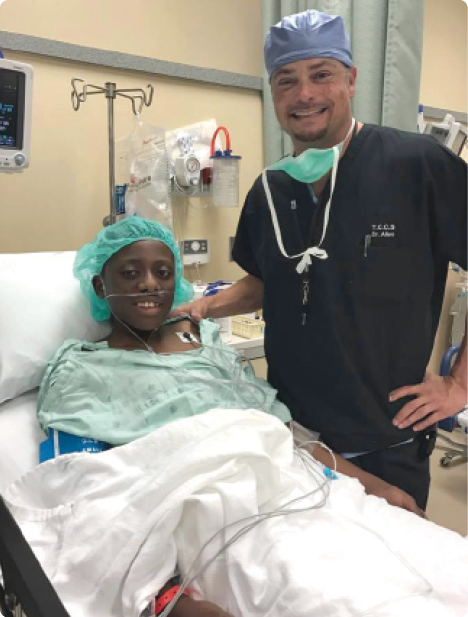
“With coordination between our office and the surgery center, we were able to offer charity care, and the surgery, anesthesia, and surgical center charges were all waived,” Dr. Allen says.
On postoperative day 1, the visual acuity measured 20/50 in the right eye and 20/30 in the left eye. The teenager was already able to see well enough that he was inquiring about when he could start playing sports again. His refraction 1 week postoperatively was -0.50 +0.50 × 180 OD = 20/25 and -0.75 +0.75 × 90 = 20/25 OS. The patient is thrilled to have his vision back and excited to be back in school and sports. He is relieved and happy that, now, all he needs are glasses for reading, but for distance and computer vision, he is functioning well.
Dr. Allen is a consultant to Alcon and Valeant.
1. Hoffman RS, Vasavada AR, Allen QB, et al; the ASCRS Cataract Clinical Committee, Challenging/Complicated Cataract Surgery Subcomittee. Cataract surgery in the small eye. J Cataract Refract Surg. 2015;41(11):2565-2575.
2. Allen QB. Navigating multifocality & toricity in the US. Paper presented at: Advanced Refractive Congress; July 29, 2017; Fort Lauderdale, FL.

